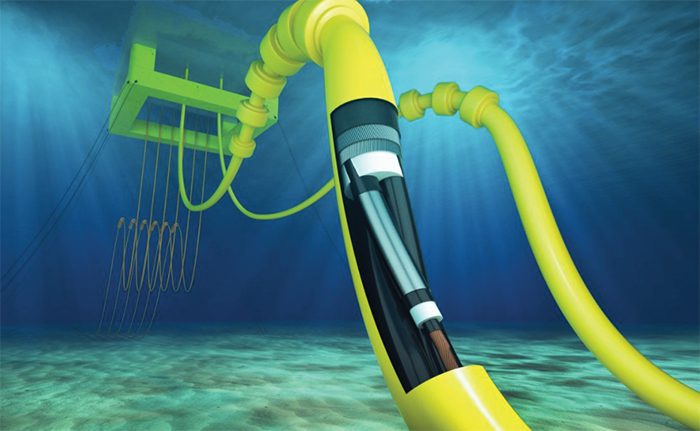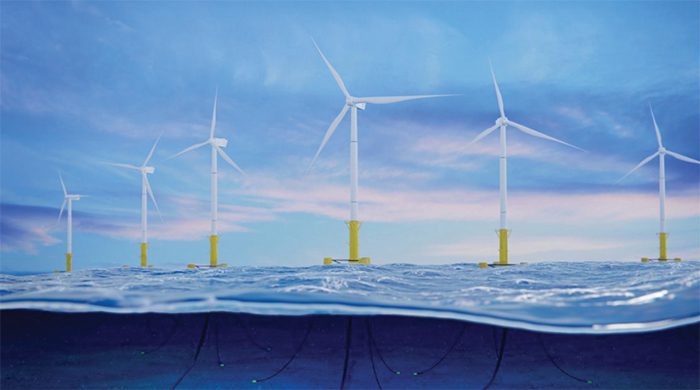Dynamic Export Cables Help Unlock Potential of Offshore Wind Power

The need to boost renewable energy production and infrastructure has never been higher. Offshore wind power is a crucial part of achieving net-zero emissions and has tremendous potential. As more and larger wind farms are installed across the world, the deployment of more powerful turbines has established the offshore wind sector as a modern giant of the energy sector.
The offshore and ocean wind industry has experienced dramatic growth in Europe, and the U.S. sector appears poised for substantial growth as well. The dynamic export cable, also known as an umbilical, is an essential subsea power transmission component. The cables are an integral part of bringing energy from ocean and offshore wind turbines to where it's needed onshore, and a technology critical to the success of the industry.
While Europe, in particular the UK and Germany, continues to lead the way with the largest offshore wind markets, China and the U.S. are driving strong growth in the sector. The World Forum for Offshore Wind recently said China currently has a market-leading 4.4 GW of offshore wind under construction, as well as more then 7 GW in operation-and as recently as 2019 was targeting having more than 40 GW installed by next year.
American Clean Power, an advocacy group for the U.S. sector, said more than 9 GW of new offshore wind is planned off the nation's coastlines in the next five years. The Department of Energy's National Renewable Energy Laboratory in late August said the pipeline for U.S. offshore wind energy projects grew to more than 35 GW in the past year, a 24% increase over the previous year.
The UK, meanwhile, has a goal of 40 GW of installed offshore wind by 2030, up from its current total of about 10.5 GW. Germany has about 8 GW of installed capacity, although officials recently said no new offshore installations are expected this year.
Most wind farms currently are being developed in prime shallow-water locations with a depth of up to 50 to 60 meters. The fixed-bottom wind turbines anchored to the seafloor used in these projects is well-established technology.
Yet, up to 80% of the world's best wind resources can be found in areas where the water is much deeper, meaning a major chunk of offshore wind potential remains untapped. But this is changing thanks to the advancement of floating wind technology (Figure 1), including dynamic export cables.
 |
1. Growth in the offshore wind industry is dependent on the ability to install turbines in deep water locations, further offshore where wind speeds are greater. Up to 80% of the world's best resources are in areas where water is much deeper. Floating wind turbine designs are helping the power industry gain access to these resources. Courtesy: Nexans |
Floating wind farms and accompanying transmission technology enable the energy industry to expand into deeper waters where winds are stronger and more consistent, such as the Mediterranean, the U.S. West Coast, offshore of Japan and Korea, and in the Norwegian North Sea. Installing the foundations for offshore wind farms in deeper waters is difficult-not only is it prohibitively expensive, it's also impractical. Instead, the wind turbines need to be mounted on floating structures that are tethered in position. Eliminating the depth constraint opens the way for large-scale power generation from deeper waters.
Floating wind turbines reduce the cost of installation and maintenance as a large part of turbines can be assembled on land and towed out to the anchor point, instead of being built on-site. Floating turbines can also be towed closer to shore for easier and less costly maintenance.
Like conventional offshore wind farms, exporting energy from floating wind farms requires high-capacity submarine cable systems. However, unlike bottom-fixed wind farms, they require dynamic power cables (Figure 2). These cables need to withstand additional variables such as the movement of the floating platforms, large tensile loads due to the water depths, and significant hydrodynamic stresses generated by waves and currents. While conventional submarine cables are installed or secured on the seabed, the technology for moving energy from floating offshore wind turbines to the shore requires dynamic cables that are characterized by excellent mechanical strength.
 |
2. Floating wind farms require high-capacity submarine cable systems, including dynamic export power cables. The cables need to withstand variables such as movement of the floating platforms, large tensile loads in deep water, and the hydrodynamic stresses generated by waves and currents. Courtesy: Nexans |
Offshore wind farms that are good candidates for larger floating turbines are divided into two geographical groups. The first is where water depths reach between 100 and 200 meters, suiting locations such as the UK, the European Atlantic coast, South Korea, and the North Sea. The second group could satisfy wind farms in waters up to 10 times deeper, such as the U.S. West Coast and the Mediterranean.
When it comes to dynamic cables, lessons can be learned from the oil and gas industry. A lot of knowledge and infrastructure relating to umbilical systems and the structural behavior of dynamic cables used in offshore oil and gas exploration can be transferred to dynamic high-voltage submarine cable systems.
Collecting power from floating wind farms requires the development of new-generation cables capable of handling higher and higher levels of power. While individual turbines currently produce 7 MW to 10 MW, a new generation of giant turbines is on its way, readily available for 15 MW-and they will eventually reach power levels of about 20 MW or more.
To enable the dynamic cables to carry more power to connect commercial floating wind parks to shore, higher voltages are necessary-which means that under no circumstances can there be water intrusion into the insulation. Like static cabling, these dynamic cables need a water barrier. Such a barrier is usually achieved by extruding a lead sheath on the cable, but because this cannot flex with dynamic wave movement, it is unsuitable for floating wind applications.
Another challenge for cables installed in large water depths is their weight, since during installation they represent a large tensile load hanging from the cable-laying vessel. These challenges require alternative designs, such as using a metallic alloy foil or polymer sandwich between the cable's insulation and the jacket for higher voltages. This barrier must be thin enough to move and flex with the cable's movement, yet thick enough to provide adequate water tightness and protection along several kilometers (km) of cable. New designs should account for aspects such as strength, flotation, flexibility, and temperature regulation, among others.
It is also possible to integrate optical fiber elements within the dynamic power export cables, at a minimal additional cost, to enable end-to-end communication. This can act as an early-warning sensor to alert operators when any part of the cable suffers a sudden surge in temperature or comes under stress.
Equinor, an international energy company with its roots in Norway, provides an example of this practice. Equinor in 2009 became the first major oil and gas operator to transition into floating wind farms when the company installed the world's first floating turbine in the North Sea off the coast of Norway. Known as the Hywind Demo, the unit is based on a 2.3-MW turbine with a rotor diameter of 82 meters.
After eight years of successful operation, Equinor then commissioned the world's first full-scale floating wind farm, the Hywind Scotland Pilot Park, located about 30 km off the coast of Aberdeenshire in Scotland. With a rotor diameter of 154 meters and a height of 253 meters, the floating farm generates enough energy to power roughly 20,000 homes. A unique feature is that the giant masts and turbines sit in buoyant concrete-and-steel keels that enable them to stand upright in the water, similar to a bob float used for fishing.
With an installed capacity of 30 MW, the wind farm comprises five 6-MW wind turbine generators. These are connected through a dynamic inter-array cable network before feeding back into a single 30-km-long dynamic export cable carrying energy back to land in Peterhead, Scotland.
The cable systems were tested, sealed off, prepared for pull-in, and delivered in individual lengths, ready for installation. The Hywind Scotland array covers approximately 4 square kilometers. Water depths vary between 95 meters and 129 meters, with an average wave height of 1.8 meters, while the average wind speed is 10 meters per second (m/s). The success of Hywind Scotland has sparked the deployment of other floating turbines, with more in the pipeline across Europe and the world.
Equinor also recently began construction of the world's first floating wind farm to power offshore oil and gas platforms, Hywind Tampen. The project will act as a testbed to explore the integration between gas and wind power generation systems and further develop floating wind technology. It will also offset 200,000 metric tons of CO2 and 1,000 metric tons of NOx emissions per year.
Technologies are rapidly evolving, and the expanding size and generation capacity of turbines has played a decisive role in making these offshore wind farms easier and cheaper to construct and operate. This, in turn, should unlock their market potential and help countries around the world realize a cost-effective and carbon-neutral way to solve their growing energy transition needs.
According to the International Energy Agency (IEA), by moving into deeper waters, offshore installations using floating wind turbines could have the potential to meet the world's electricity demand several times over by 2040. The Carbon Trust, a UK-based group formed two decades ago to help businesses measure their carbon impact, in a recent report said the global aspiration for floating wind could reach 10.7 GW by 2030, and up to 34 GW by 2035.
The technology costs for floating offshore wind farms are expected to fall rapidly, enabling wind energy to be harnessed in areas once thought inaccessible. Ultimately, floating wind farms are set to become a crucial part of the world's energy mix.
-Maxime Toulotte is head of technical marketing at Nexans, a global cable and optical fiber company headquartered in Paris, France. POWER Senior Associate Editor Darrell Proctor contributed to this report.
The post Dynamic Export Cables Help Unlock Potential of Offshore Wind Power appeared first on POWER Magazine.